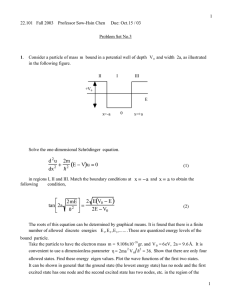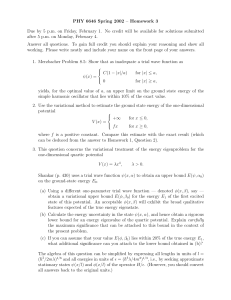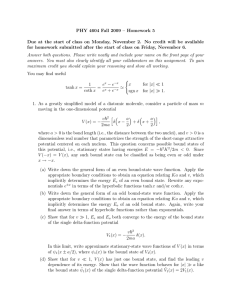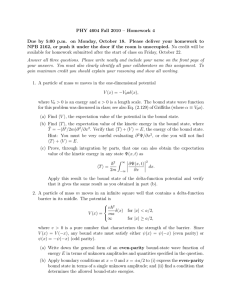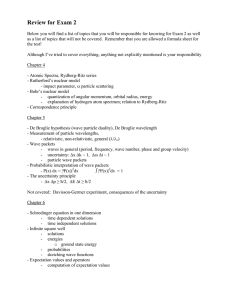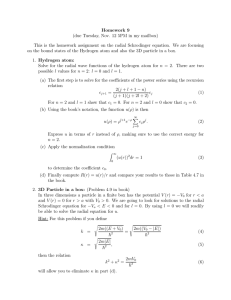PHY 4604 Fall 2008 – Homework 4
advertisement
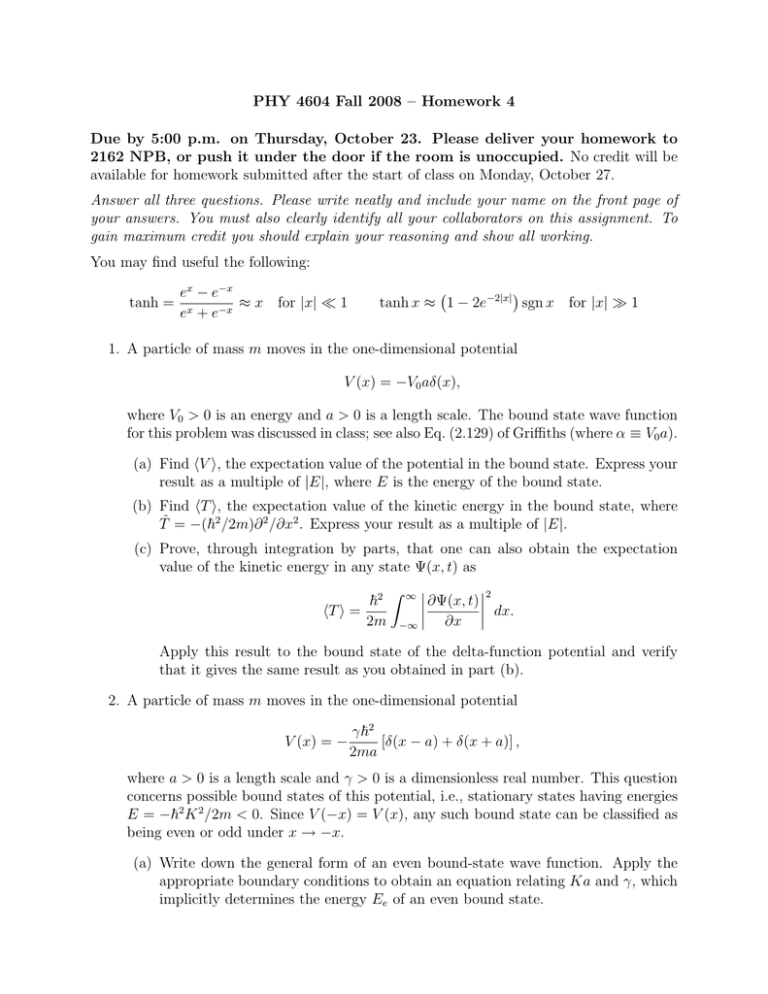
PHY 4604 Fall 2008 – Homework 4 Due by 5:00 p.m. on Thursday, October 23. Please deliver your homework to 2162 NPB, or push it under the door if the room is unoccupied. No credit will be available for homework submitted after the start of class on Monday, October 27. Answer all three questions. Please write neatly and include your name on the front page of your answers. You must also clearly identify all your collaborators on this assignment. To gain maximum credit you should explain your reasoning and show all working. You may find useful the following: tanh = ex − e−x ≈ x for |x| 1 ex + e−x tanh x ≈ 1 − 2e−2|x| sgn x for |x| 1 1. A particle of mass m moves in the one-dimensional potential V (x) = −V0 aδ(x), where V0 > 0 is an energy and a > 0 is a length scale. The bound state wave function for this problem was discussed in class; see also Eq. (2.129) of Griffiths (where α ≡ V0 a). (a) Find hV i, the expectation value of the potential in the bound state. Express your result as a multiple of |E|, where E is the energy of the bound state. (b) Find hT i, the expectation value of the kinetic energy in the bound state, where T̂ = −(~2 /2m)∂ 2 /∂x2 . Express your result as a multiple of |E|. (c) Prove, through integration by parts, that one can also obtain the expectation value of the kinetic energy in any state Ψ(x, t) as Z ∞ ∂Ψ(x, t) 2 ~2 dx. hT i = 2m −∞ ∂x Apply this result to the bound state of the delta-function potential and verify that it gives the same result as you obtained in part (b). 2. A particle of mass m moves in the one-dimensional potential V (x) = − γ~2 [δ(x − a) + δ(x + a)] , 2ma where a > 0 is a length scale and γ > 0 is a dimensionless real number. This question concerns possible bound states of this potential, i.e., stationary states having energies E = −~2 K 2 /2m < 0. Since V (−x) = V (x), any such bound state can be classified as being even or odd under x → −x. (a) Write down the general form of an even bound-state wave function. Apply the appropriate boundary conditions to obtain an equation relating Ka and γ, which implicitly determines the energy Ee of an even bound state. (b) Write down the general form of an odd bound-state wave function. Apply the appropriate boundary conditions to obtain an equation relating Ka and γ, which implicitly determines the energy Eo of an odd bound state. (c) Approximate the energies Ee and Eo in the limit γ 1, keeping sufficient accuracy that you capture the leading nonvanishing term in the difference Eo − Ee . Show that as γ → ∞, Ee and Eo both converge to the energy of the bound state of the single delta-function potential V1 (x) = −γ~2 /(2ma)δ(x), and relate the wave functions of V (x) to that for V1 (x). (d) Show that there is only one bound state in the limit γ 1, and find the leading γ dependence of its energy. Show that the wave function behaves for |x| a like the bound-state wave function of the single delta-function potential Ṽ1 (x) = −γ~2 /(ma)δ(x). [Note that Ṽ1 (x) is twice the potential V1 (x) introduced in (c).] (e) Find the minimum value γ = γ2 for which the potential V (x) supports two bound states. Sketch the form of the bound-state wave functions ψe (x) and ψo (x) for γ just greater than γ2 (say, γ = 1.1γ2 ). Make sure that your graph covers the entire region |x| < 5a. Label the points x = ±a on the horizontal axis. (f) Sketch a graph of the bound-state equations that you found in parts (a) and (b). Your graph should plot Ka along the horizontal axis and γ along the vertical axis. Describe a graphical method for finding the bound state energies, and illustrate its use (schematically—there is no need to draw a scale plot) for γ = 2. (g) Use a numerical method of your choice—e.g., trial and error substitution into the equations that you found in parts (a) and (b)—to determine the bound-state energy (or energies) for γ = 2 as a multiple (or multiples) of ~2 /(2ma2 ). Give your answer (or answers) accurate to three significant figures. 3. A particle of mass m moves in the one-dimensional potential V (x) = V0 Θ(x) + V1 aδ(x), where V0 and V1 are positive energy scales, a > 0 is a length scale, and Θ(x) is the Heaviside or step function: 0 for x < 0, Θ(x) = 1 for x > 0. This question focuses on stationary states with an energy E > V0 . (a) Write down the general form of the wave function in the regions x < 0 and x > 0. (b) Apply the appropriate boundary conditions to construct the wave function ψr (x) describing a rightward moving particle incident from the far left, plus any reflected and transmitted products. (c) Find the transmission probability T (E).
